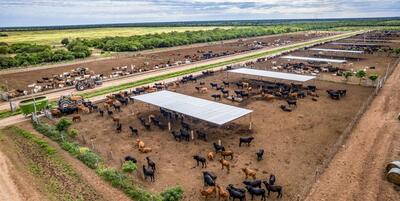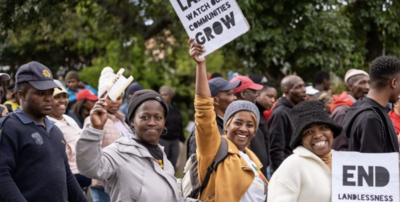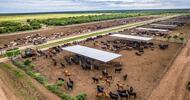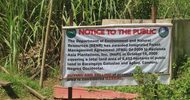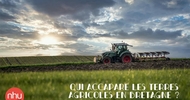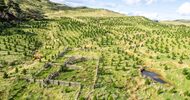Huge beef farm hits market
by Chris McCullough
GRAN CHACO, PARAGUAY – Producing beef at half the cost of farmers in the United States, the European Union and Australia is just one of the selling points of a huge farm in Paraguay that’s on the market. The price tag is a hefty $91 million, which breaks down to $66 million for the land and property and about $25 million for all stock, plant and equipment.
La Huella Farm, situated in the Gran Chaco region of Paraguay, about 90 miles northwest of Loma Plata, Paraguay, has been put on the market by its German owners. The farm extends to about 109,000 acres owned, and has another 112,000 acres under lease and 81,000 acres managed through capitalization agreements. In terms of stock, La Huella runs about 50,000 head of cattle including 18,000 breeding crossbred-beef cows mostly consisting of the Brahman, Zebu and Brangus breeds. About 80 staff members work at La Huella, with a number of them living on-site together with their families.
La Huella was purchased by Limited Liability Company (Ltd) back in 2010 as bare land. After gradual development of infrastructure and the herd, it was fully functionable by 2015. The current owners have decided to release the farm to the market now because beef prices continue to soar, plus the fact they are in their 70s.
German-born Andreas Lienert has been the CEO of the La Huella Group since 2015. He said the farm is an excellent investment opportunity for those with the skillset to take it further.
“La Huella operates a full-cycle cattle system that includes breeding, rearing and fattening,” he said. “While the farm originally began as a fattening operation, logistical challenges in sourcing a sufficient number of young cattle led to a strategic shift. Over the past years, the focus has moved toward breeding, and today the farm is primarily positioned as a supplier of high-quality calves.
“In addition, we are actively involved in genetic-development programs, with the main goal of producing our own breeding bulls. La Huella is also proud to own King George, a Brangus bull recognised as a world champion in his class.”
Each grazing paddock on the farm consists of about 124 acres. Half the grazing plots have electric-fence control.
“We employ a rotational grazing system, utilizing about 12 percent of the plots at any given time to allow for pasture recovery, ensuring sustainable forage production,” he said. “As a result, the herds are sometimes rotated on a daily basis.
“We run hybrid breeds resulting from the crossbreeding of European Angus and Hereford cattle with Zebu breeds, primarily Nelore and Brahman. In recent years we’ve placed a strong emphasis on the development of the Brangus breed.
“To ensure high-quality beef production, our herd genetics are approximately 63 percent European, providing superior meat characteristics. The remaining Zebu influence ensures excellent adaptability to the demanding climatic conditions of the Paraguayan Chaco.”
The farm-owned land at Estancia La Huella runs about 28,000 head of cattle across all categories. In recent years a breeding herd of 16,000 to 18,000 beef cows has been established.
“During the past year, approximately 13,000 calves were born – 11,500 during the spring and 1,500 in the fall,” Lienert said. “We retain a portion of the heifer calves to replace non-productive cows, while the remaining heifers are either sold directly or through auctions. Some of the male calves are fattened on the farm, but the majority are sold annually as weaners.
“Breeding is also the primary focus on our leased properties and in our capitalization partnerships. The breeding herd consists of mature cows and first-service heifers. Male calves are primarily sold as weanlings to finishing operations, while a portion of female calves are selected for our 20-percent-herd-replacement policy. Initially raised on pasture, these heifers undergo a 120-day confinement period, after which they either join the breeding herd if pregnant or transition to the finishing system.
“Replacement heifers are selected based on reproductive performance and adaptability. They are raised from weaning, starting on pasture until reaching approximately 280 kilograms (about 617 pounds), followed by confinement where they gain around 700 grams per day (about 1.5 pounds), exiting at 360 kilograms (about 794 pounds).
“We also produce breeding bulls to enhance the genetic quality of our commercial herd. We carry out around 2,500 embryo transfers each year. High-quality sires are retained, while surplus bulls and females are marketed through breeding auctions.”
A number of males and females are finished for slaughter, with the males reared on-pasture from 250 kilograms – about 551 pounds – to 380 kilograms – about 838 pounds, then finished in confinement pens over approximately 100 days, reaching slaughter weight at 500 kilograms – about 1,100 pounds.
Heifers not selected as replacements are pasture-reared from 220 kilograms – about 441 pounds – to 350 kilograms – about 772 pounds, followed by feedlot finishing to 450 kilograms – about 992 pounds.
All calves are born and raised on open pasture, with conception achieved either through fixed-time artificial insemination or natural service using selected bulls. The breeding season at La Huella begins each year in October and typically ends by the end of January. As a result, calving starts about July. All animals are kept on-pasture year-round; there are no barns or shelters.
La Huella operates its own feedlot with a capacity of between 2,800 and 3,600 animals. Feed, mainly corn and sorghum, is either purchased externally or produced on the farm. In addition, the farm produces about 12,000 hay bales annually on about 1,927 acres. Those serve as a strategic feed reserve for the July-to-October dry season, for supporting calves during weaning and for various planned supplementation programs throughout the year.
Cattle at La Huella are primarily grazed year-round on Gatton Panic, an excellent-quality forage grass cultivated on-site. The consistent in-house forage production supports sustainable and efficient feeding practices across all livestock categories, Lienert said.
“The native pastures of the Paraguayan Chaco lack the nutrient density required to support optimal livestock performance,” he said. “To address this, Gatton Panic – which is a widely used forage species in tropical regions – was introduced at La Huella. It needs no fertilizer, has a fast growth rate and high drought tolerance. It contains a moderate protein content of approximately 10 percent and yields an average of 10,000 kilograms of dry matter per hectare per year (about 8,922 pounds per acre).”
One of the more-difficult challenges of farming within the Paraguayan Chaco is managing the variable rainfall. Both drought and excessive rainfall can negatively impact operations. Because the farm is not connected to public water or the electricity grid, it relies on solar energy and rainwater harvesting from extensive catchment areas to supply water and power for animals, facilities and staff.
“La Huella faces climatic challenges posed by the La Nina and El Nino phenomena, which significantly impact rainfall patterns,” Lienert said. “To mitigate these effects, we have implemented the Poseidon Control de Agua en el Ganado system, enabling real-time monitoring and management of water resources.
“On average, we receive between 650 millimeters and 850 millimeters of rainfall per year (26 to 34 inches). Our water-supply strategy includes the creation of multiple artificial reservoirs and storage tanks designed to capture and retain rainfall during the summer rainy season from November to April, which accounts for approximately 80 percent of the farm’s annual water needs.”
An extensive water-distribution network services 250 water troughs across the property, providing each animal with water. In emergency situations the farm uses saline groundwater, unsuitable for human consumption, which is carefully diluted with stored rainwater to maintain livestock hydration.


